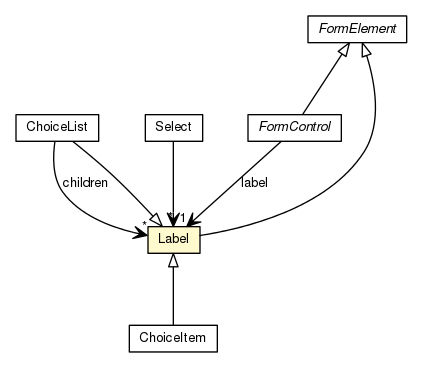Class Label


public class Label extends FormElement
FormControl.PROP_CONTROL_LABEL. A
label reveals the intent of the corresponding form control for human users
primarily as a string. This string is stored using the standard property
rdfs:label (see
Resource.getResourceLabel() and
Resource.setResourceLabel(String)).| Modifier and Type | Field and Description |
|---|---|
static String |
MY_URI |
static String |
PROP_ICON_URL
The URL of media objects that can be used as an audio / visual icon
equivalent to the meaning borne by the text label.
|
PROP_APPEARANCEANON_URI_PREFIX, blockAddingTypes, isXMLLiteral, NAMESPACE_PREFIX, ns_delim_index, PROP_INVOLVED_HUMAN_USER, PROP_RDF_FIRST, PROP_RDF_REST, PROP_RDF_TYPE, PROP_RDFS_COMMENT, PROP_RDFS_LABEL, PROP_SERIALIZATION_FULL, PROP_SERIALIZATION_OPTIONAL, PROP_SERIALIZATION_REDUCED, PROP_SERIALIZATION_UNDEFINED, props, RDF_EMPTY_LIST, RDF_NAMESPACE, RDFS_NAMESPACE, SERVICE_NAMESPACE, TYPE_RDF_LIST, TYPE_RDFS_CLASS, uri, VOCABULARY_NAMESPACE| Constructor and Description |
|---|
Label()
For use by de-serializers only.
|
Label(String labelText,
String iconURL)
Constructs a new label.
|
| Modifier and Type | Method and Description |
|---|---|
String |
getIconURL() |
String |
getText()
Returns the label string.
|
boolean |
setProperty(String propURI,
Object value)
Adds a statement with this resource as the subject, the given
propURI as the predicate and the given value as the object. |
String |
toString()
Overrides
Resource.toString() in
order to return the label string; only if this is an empty string, the
default implementation is used. |
addAppearanceRecommendation, getAppearanceRecommendationsaddType, getLocalName, getNamespace, getProperty, getPropertyURIs, getType, getTypes, getURI, hasQualifiedName, isAnon, numberOfPropertiesaddMultiLangProp, asList, asList, asRDFList, changeProperty, copy, deepCopy, equals, generateAnonURI, getDefaultLang, getFilename, getMultiLangProp, getOrConstructLabel, getOrConstructLabel, getPropSerializationType, getResource, getResourceComment, getResourceLabel, getResourceLabel, getStaticFieldValue, hashCode, hasProperty, isAnon, isBlockingAddingTypes, isClosedCollection, isQualifiedName, isWellFormed, literal, representsQualifiedURI, serializesAsXMLLiteral, setPropertyPath, setPropertyPath, setPropertyPathFromOffset, setResourceComment, setResourceLabel, toStringRecursive, toStringRecursive, unliteralpublic static final String MY_URI
public static final String PROP_ICON_URL
public Label()
public Label(String labelText, String iconURL)
labelText - Mandatory string bearing the intent of the corresponding form
control for human users and stored using the standard property
rdfs:label.iconURL - See PROP_ICON_URL; optional.public String getIconURL()
PROP_ICON_URLpublic String getText()
Resource.getResourceLabel()public boolean setProperty(String propURI, Object value)
ResourcepropURI as the predicate and the given value as the object.
Subclasses must override this in order to decide if the statement to be
added fits the general class constraints. If not, the call of this method
should be ignored. For each property only one single call may be made to
this method, unless subsequent calls to this method for setting the value
of the same property are treated as an update for an update-able
property. Multi-valued properties must be set using an instance of
List. The differentiation, if a such list should be
treated as an rdf:List, can be made with the help of
Resource.isClosedCollection(String). The default implementation here
accepts all property-value pairs blindly except for rdf:type which is
handled if the value is a type URI, a Resource or a java.util.List of
them.
Note: The setting of the property rdf:type is being handled by this class
via the final methods Resource.addType(String, boolean),
Resource.getType(), and Resource.getTypes(). Although these methods give
the view of handling type URIs as strings, but in reality the types are
stored as direct instances of this class. So, the subclasses should
ignore calls for setting rdf:type; if not, then the subclass must pay
attention that the value should be a List of direct instances of
this class so that (1) the Resource.toString() method returns just the
URI and (2) the serializers get no problems with the value. Also,
settings via subclasses may be overwritten by this class if a subsequent
call to Resource.addType(String, boolean) is made.
setProperty in class ResourceResource.setProperty(String, Object)public String toString()
Resource.toString() in
order to return the label string; only if this is an empty string, the
default implementation is used.Copyright © 2018 universAAL Consortium. All rights reserved.